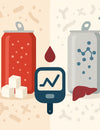
This study was conducted to evaluate the preventive effect of EPA and DHA on cardiovascular disease (Bernasconi AA, et al., 2020). EPA and DHA are the active ingredients of omega 3 fat.
The research included 135,267 participants from 40 studies.
The researchers found that supplementation with EPA and DHA was associated with reduced risk of myocardial infarction.
The researchers concluded that supplementation with EPA and DHA is an effective lifestyle strategy for cardiovascular disease prevention, and the protective effect probably increases with dosage.
Where do you find EPA and DHA? You find it in fish oil. You find omega 3 fat in flax seeds also, but that type of fat has to be converted by the body to EPA and DHA. This conversion is however not very efficient. The omega 3 fat found in fish oil comes as EPA and DHA, ready for the body to use.
Fish oil in triglyceride form is better absorbed than ethylester, a more common form of fish oil (Beckermann B, et al., 1990). The triglyceride form is also more stable.
References
Beckermann B, Beneke M, Seitz I. [Comparative bioavailability of eicosapentaenoic acid and docasahexaenoic acid from triglycerides, free fatty acids and ethyl esters in volunteers]. Arzneimittelforschung. 1990 Jun;40(6):700-4.
Bernasconi AA, Wiest MM, Lavie CJ, Milani RV, Laukkanen JA. Effect of Omega-3 Dosage on Cardiovascular Outcomes: An Updated Meta-Analysis and Meta-Regression of Interventional Trials. Mayo Clin Proc. 2020 Sep 17:S0025-6196(20)30985-X.










